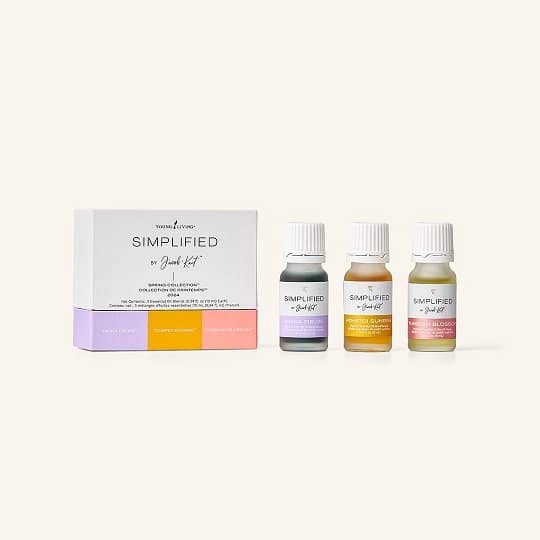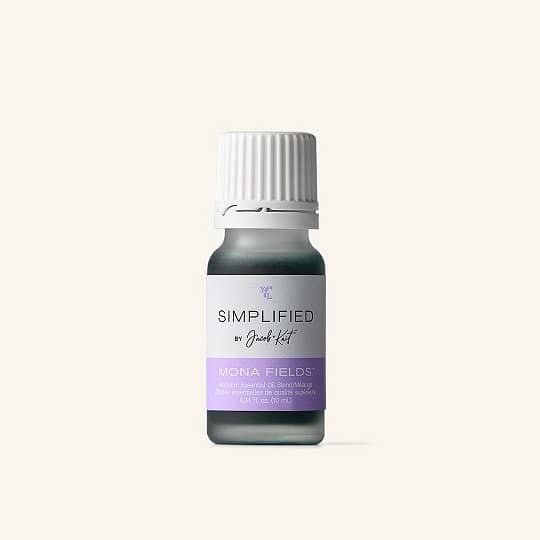Simplified By Jacob + Kait™ Spring Collection™ 2024
A collection of spring-scented essential oil blends just for the smell of it™. Includes Mona Fields™, Pompeii Sunrise™, and Tunisian Blossom™ blends. Let the Simplified by Jacob + Kait Spring Collection transport you to blooming lavender fields, faraway citrus groves, and Mediterranean shores. Each blend evokes the fresh essence of spring without harmful synthetic chemicals. Experience the all-natural fragrances of Mona Fields™, Pompeii Sunrise™, and Tunisian Blossom™ blends, transforming your home into a springtime getaway.
Product Profile
Mona Fields essential oil blend, 10 ml
- Has an earthy, floral, relaxing aroma
- Inspired by the Young Living Mt. Nebo Botanical Farm in Mona, Utah
- Features Lavender, Clary Sage, Goldenrod, Orange, Blue Yarrow, Juniper, and Davana essential oils
Pompeii Sunrise essential oil blend, 10 ml
- Has a sweet, zesty, uplifting aroma
- Evokes a fragrant citrus grove at dawn
- Combines Grapefruit, Lemon, Lime, Orange, and Peppermint essential oils with Vanilla oleoresin
Tunisian Blossom essential oil blend, 10 ml
- Has a beautiful, floral, citrus aroma
- Transports you to an idyllic Mediterranean getaway
- Made with Orange, Neroli, Yuzu, Bergamot, , Black Pepper, and Xiang Mao essential oils
Product Use & Tips
Suggestions from Young Living
- Aromatic: Diffuse up to 1 hour 3 times daily. For a light aroma, use 4–6 drops. For a stronger aroma, use 10–15 drops.
- Topical: Dilute 1 drop of selected blend with 2–4 drops of V-6™ Vegetable Oil Complex or carrier oil. Test on a small area of the skin on the underside of your arm, then apply to the desired area as needed.
- Diffuse to start your morning on a fresh, idyllic note.
- Make a DIY linen spray with 1 ounce of witch hazel, 3 ounces of distilled water, and 15 drops of your chosen blend.
- Create your own roll-on fragrance: Add 10–20 drops of essential oil to a roller bottle and fill with carrier oil.
- Mix into your personal care products for a natural, non-synthetic fragrance.
- Add to your spring-cleaning sprays to make your home smell amazing.
- Use in place of candles, air fresheners, and other synthetic-scented products.
Related to this Product
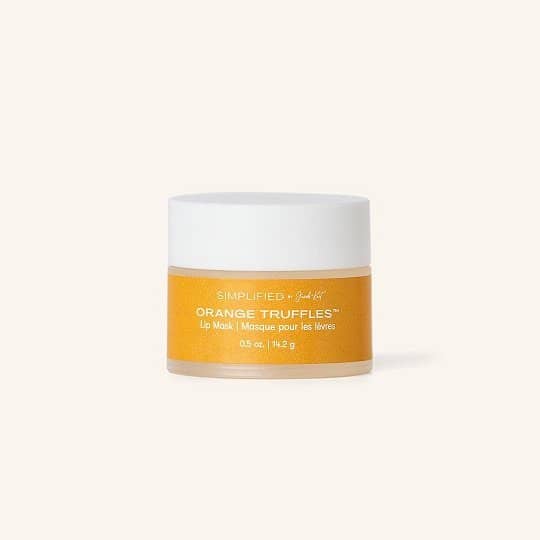
Orange Truffles Lip Mask
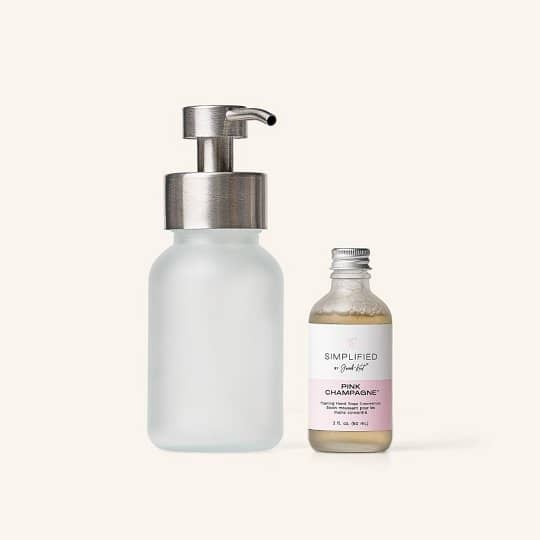
Pink Champagne Foaming Hand Soap Concentrate Collection

Simplified By Jacob & Kait – Summer Collection
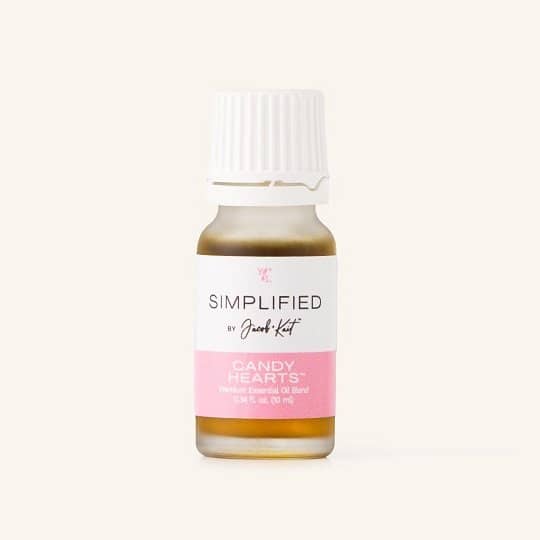
Simplified by Jacob + Kait Candy Hearts essential oil blend
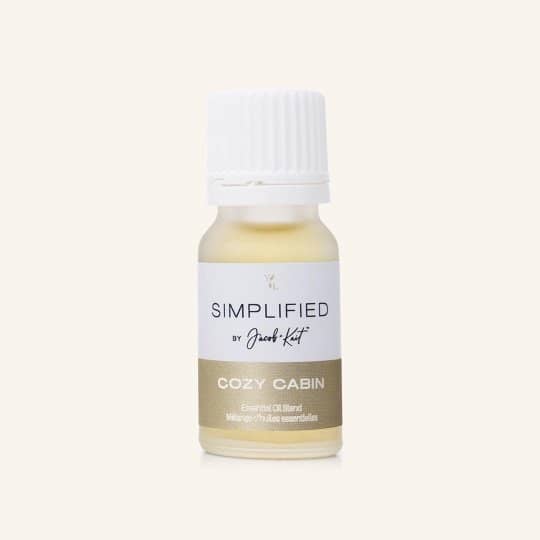
Simplified By Jacob + Kait Cozy Cabin Essential Oil Blend

Simplified by Jacob + Kait Cozy Chai Essential Oil Blend
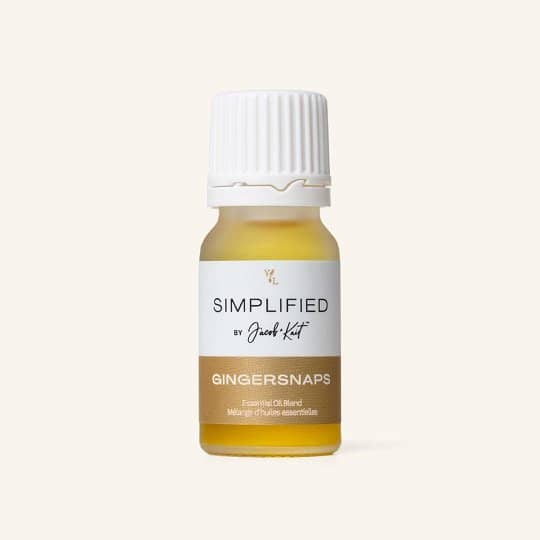
Simplified By Jacob + Kait Gingersnaps Essential Oil Blend
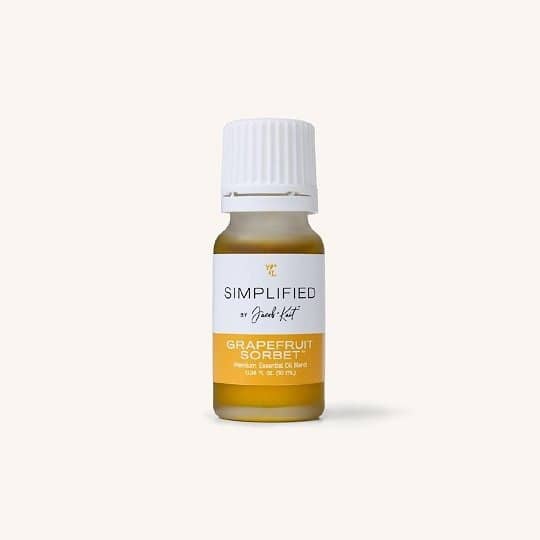
Simplified by Jacob + Kait Grapefruit Sorbet Essential Oil Blend

Simplified by Jacob + Kait Lemon Pound Cake essential oil blend

Simplified By Jacob + Kait Orange Spiced Cider Essential Oil Blend
Diffusing Notes
These are approximate drops. Adjust recipes to your needs. If a recipe is too strong for you, add fewer drops. Do you need more? Just add more, but no more than 8-12 drops for all of our diffusers with the exception of the Aria diffuser which requires 15-25 drops.
Tip: When you first begin diffusing, start with less essential oil than listed in the recipes and build to more as desired. You should give your body time to adjust to the essential oils. Almost all the Young Living diffusers are ultrasonic which provides a cool-mist humidifier along with the essential oils. These diffusers are safe to run all day. Pay attention to the size of the room because the size will impact the intensity of diffusing. Nebulizers and atomizers are different than ultrasonic diffusers because they do not use water. For these, note the time limit for diffusing stated on each individual oil bottle.
Ultrasonic Diffusers
Ultrasonic diffusers work by using vibrations to break down water and essential oils into tiny particles, creating a fine mist that is released into the air. Inside the diffuser, there’s a small disc that vibrates rapidly, usually at ultrasonic frequencies (beyond what humans can hear). This vibration agitates the water and oil mixture, breaking it into micro-droplets that are then dispersed as a mist. This mist carries the pleasant aroma of the essential oils and tiny water particles, helping to humidify the air and spread the fragrance throughout a room. Ultrasonic diffusers are popular for their ease of use, quiet operation, and ability to provide both aromatherapy benefits and a visually appealing ambiance.
Cleaning Your Diffuser
- Always turn off and unplug the diffuser prior to cleaning.
- To ensure proper performance, clean the ultrasonic plate and lid after each use.
- If essential oil begins to build up on the ultrasonic plate, gently wipe it off using a cotton swab dipped in rubbing alcohol.
- If essential oil begins to build up on the lid, gently wipe it off using mild soap and water only.
- Never use a corrosive detergent to clean the ultrasonic plate or damage will occur.
- Periodically check under the diffuser to keep the fan intake free of debris.
- Debris can be removed by blowing on the fan intake opening or wiping with a clean, dry cloth. (Do not use aerosol sprays, solvents, or abrasives to clean the plastic housing.)
- When not in use, clean the diffuser and store dry. Replacement ultrasonic plates can be purchased from Young Living.
Aromatherapy
When odorant molecules attach to odorant receptors, your body responds by sending electrical impulses into your brain. This causes different physiological reactions depending on the aromas detected.
The sense of smell has a profound impact on your emotions and inner desires. Those scents can set the mood or bring up memories before you are even aware of it.
Aromas impact your body and they can set the mood and atmosphere in any environment.
The sense of smell is directly connected to the limbic lobe of your brain, also known as the emotional control center. The limbic lobe plays a big role in your mood, memory, behavior, feelings, and emotions, and it is connected to the olfactory bulb in the nose.
How to Use Essential Oils
Aromatically, Topically, Internally & Safely
You just purchased a bundle, kit, or collection of essential oils. Now you’re overwhelmed by how to use them. We’ve all been intimidated by how to use essential oils. With a little practice and this simple guide, you’ll be an expert in no time.
This video covers how to use essential oils:
• Aromatically
• Topically
• Internally
• Safely
How to Apply Essential Oils - Three Main Methods
Stumped on how to apply your essential oils? How you apply an oil depends on what benefit you want to get out of it. Different oils offer different benefits, depending on how and where you apply them. So, before using any new essential oil, be sure to check that oil’s uses and benefits and read any labels and instructions that come with it. If you have questions or concerns, check with your healthcare provider.
Using Essential Oils Aromatically
Let’s start with the hallmark way to use essential oils: aromatically. All essential oils feature a signature aroma you can smell and inhale for various effects. One oil’s crisp scent can invigorate you when you need a midday pick-me-up. Another’s soothing aroma can help you unwind after a tough day. You can use essential oils aromatically by simply opening the bottle and inhaling its aroma. They can also be applied topically as a personal fragrance, but always dilute them with a carrier oil, which is a plant-derived oil like coconut or almond oil. Dilute a few drops of essential oil with your carrier oil and then rub it into your palms and inhale or dab some behind your ear or on your neck. You can also use a diffuser to disperse the essential oil into the air.
Using Essential Oils Topically
Another favourite way to apply essential oils is topically, where you allow the oil to absorb into your skin. As mentioned before, always dilute oils with a carrier oil before you apply them topically. Topical oils can become part of a massage or added to your preferred lotion, moisturizer or other personal care product. Some oils, particularly those from the citrus family, can cause photosensitivity. A carrier oil is a plant-derived oil like coconut and almond oil that can be used to dilute an essential oil’s concentration.
Using Essential Oils Internally
If you think an oil smells terrific, wait until you taste it! You can season your favourite dish or flavor a drink with certain grades of essential oils. Ingesting oils lets you savor all their savory, herbaceous, spicy, fruity potential. The simplest ways to take essential oils internally is to add them to a glass of water, take them in a capsule or use them as seasoning. Start off with a small amount. A little goes a long way, and even a single drop might overpower your recipe. One recommendation is to dip a toothpick in the oil and stir that little bit in as a starting point. Of course, before you use any oils internally, make sure the oil is safe to ingest. Unless it specifically says on the label that it’s safe for ingestion, assume it’s safe for external use only.
Related Areas

Can essential oils expire? Understanding essential oil oxidation

Why Patents Matter to Essential Oils

How to Store Essential Oils: Get the Most Out of Each Drop

What are “hot” Oils and How Can I Use Them?

Why Should You Put Essential Oils on Your Feet?

The Science Behind Aromatherapy

Which Type of Diffuser is Right for You?

The Story Behind Essential Oil Prices
* The statements and information regarding these products have not been evaluated by the FDA. Young Living products are not intended to diagnose, treat, cure, or prevent disease. Most of the product information describing Young Living products is directly from Young Living Essential Oils, LC, and can be found online at YoungLiving.com
See more about toxins in your home.
